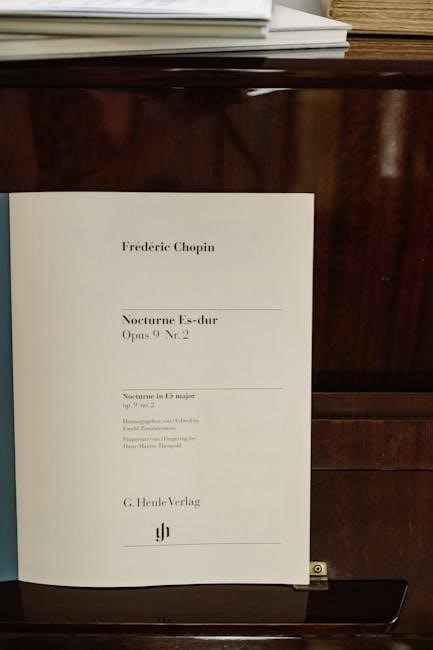Rush E piano sheet music is a viral sensation, created by Sheet Music Boss. This high-energy piece is popular among pianists for its meme-inspired, challenging yet entertaining arrangement, suitable for all skill levels.
1.1 What is Rush E?
Rush E is a high-energy piano piece composed by Sheet Music Boss, known for its challenging yet entertaining arrangement. It gained viral popularity due to its meme-inspired origins and a YouTube comment war involving creators like Penguinz0 and Fanchen; The piece is celebrated for its fast-paced, complex structure, making it both a delight and a challenge for pianists. Available in PDF and MIDI formats, Rush E offers variations, including playable and “impossible” versions, catering to different skill levels. Its unique blend of humor and musical complexity has made it a favorite in the piano community, with many artists creating covers and arrangements. Whether for practice or performance, Rush E continues to inspire pianists worldwide with its dynamic and engaging melody.
1.2 The Popularity of Rush E
Rush E has gained immense popularity due to its viral origin and engaging composition. It became a sensation after a YouTube comment war involving creators like Penguinz0, Fanchen, and Just A Guy Who Likes Hentai, sparking widespread interest. The piece’s challenging yet entertaining nature resonated with pianists and music enthusiasts alike. Its availability in PDF and MIDI formats has made it accessible to a broad audience, from beginners to advanced players. The sheet music’s versatility, with arrangements for piano, guitar, and other instruments, further boosted its appeal. Social media platforms and online communities have played a significant role in spreading Rush E’s popularity, with many artists sharing their covers and interpretations. This widespread adoption has solidified Rush E’s place as a modern favorite in piano music, driving its continuous growth in popularity.
1.3 Why Piano Players Love Rush E
Piano players adore Rush E for its unique blend of challenge and creativity. The piece’s fast-paced arpeggios and complex rhythms provide a rewarding experience, pushing pianists to refine their techniques. Its meme-inspired origin adds a layer of fun, making it a standout in modern piano music. The sheet music’s accessibility across various skill levels allows both beginners and advanced players to enjoy it. Additionally, the emotional depth and dynamic contrasts in Rush E make it engaging to perform and listen to. Many pianists appreciate the availability of MIDI files and tutorials, which aid in mastering the piece. Overall, Rush E’s combination of technical complexity and entertainment value has made it a favorite among pianists worldwide. Its viral success and community-driven adaptations further enhance its appeal, ensuring its place as a beloved piece in contemporary piano repertoire.

Background and Composition of Rush E
Rush E, composed by Sheet Music Boss, is a meme-inspired piano piece born from online viral stories. Its complex structure and high-energy rhythm make it a standout composition.
2.1 The Composer Behind Rush E
The composer behind Rush E is Sheet Music Boss, a popular YouTube channel known for creating challenging and entertaining piano arrangements. Their real identities remain anonymous, but their work has significantly impacted the piano community. Sheet Music Boss gained fame through viral pieces like Rush B and Rush E, which often blend complexity with catchy melodies. Their compositions are inspired by memes, viral videos, and online trends, making them highly relatable to younger audiences. The channel’s approach to music is unique, focusing on accessibility while maintaining artistic depth. Sheet Music Boss’s ability to transform internet culture into musical masterpieces has made Rush E a standout piece in modern piano repertoire. Their sheet music, including Rush E, is widely available in PDF and MIDI formats, catering to pianists of all skill levels; This accessibility has further boosted the piece’s popularity worldwide.
2.2 The Viral Story Behind Rush E
Rush E gained widespread popularity following a viral video by YouTuber Penguinz0 (Moist Cr1TiKal), which highlighted a humorous feud in the comments of a YouTube video. The controversy involved Just A Guy Who Likes Hentai and Fanchen, with Fanchen critiquing the video’s quality. This meme-inspired rivalry sparked a wave of interest in Rush E, transforming it into a cultural phenomenon. The piece’s viral status was further amplified by its challenging yet entertaining arrangement, making it a favorite among pianists and internet enthusiasts alike. Its rise to fame showcases how online trends can influence musical popularity, bridging the gap between memes and classical piano music. Rush E’s viral story is a testament to the power of internet culture in shaping modern music trends, with its sheet music becoming a sought-after resource for pianists worldwide.
2.3 Musical Structure and Complexity
Rush E is renowned for its intricate musical structure and challenging complexity, making it a standout piece for pianists. The composition features rapid arpeggios, complex chord progressions, and dynamic shifts, demanding precision and dexterity. Its fast-paced tempo and layered melodies create a thrilling yet demanding experience. The piece often transitions between contrasting musical themes, keeping players engaged and tested. Despite its difficulty, the sheet music is structured to allow pianists of various skill levels to approach it, with arrangements ranging from simplified versions to the original, highly complex score. The complexity of Rush E lies not only in its technical demands but also in its ability to blend harmonic richness with a high-energy rhythm, making it both rewarding and challenging to master. This unique blend has solidified its reputation as a modern piano classic.

Features of Rush E Piano Sheet Music
Rush E piano sheet music offers multiple arrangements, catering to diverse skill levels, with intricate melodies, dynamic shifts, and challenging techniques. MIDI files and tutorials are also available.
3.1 The Unique Structure of the Piece
Rush E piano sheet music is renowned for its dynamic and intricate structure, blending fast-paced arpeggios with complex melodies. The piece is divided into distinct sections, each showcasing a unique rhythm and harmony. Its composition is designed to challenge pianists, with sudden tempo changes and layered notes that create a thrilling auditory experience. The sheet music often includes detailed fingerings and pedal markings, guiding players through its technical demands. Available in both PDF and MIDI formats, Rush E’s structure allows for versatility, catering to both solo performances and collaborative plays. Its viral popularity stems from its meme-inspired origins, making it a modern classic in piano repertoire. The piece’s arrangement is both entertaining and intellectually stimulating, appealing to pianists of all levels.
3.2 Difficulty Level and Challenges
Rush E piano sheet music is categorized as an advanced piece, presenting significant technical challenges. Its rapid arpeggios, complex fingerings, and intricate rhythms require strong dexterity and hand coordination. Pianists must master precise timing and dynamic control to execute the piece effectively. The sheet music demands familiarity with advanced techniques such as chromatic runs and polyrhythms. Additionally, the piece’s fast tempo and layered harmonies can overwhelm less experienced players. Despite these challenges, the availability of both simplified and original versions allows pianists to choose their difficulty level. The PDF format ensures clarity, while MIDI files offer aural guidance. Rush E’s complexity makes it a rewarding yet demanding piece for those seeking to enhance their piano skills. Its challenging nature has contributed to its popularity, as pianists strive to conquer its technical demands and showcase their proficiency.
3.3 Variations and Arrangements Available
Rush E piano sheet music is categorized as an advanced piece, presenting significant technical challenges. Its rapid arpeggios, complex fingerings, and intricate rhythms require strong dexterity and hand coordination. Pianists must master precise timing and dynamic control to execute the piece effectively. The sheet music demands familiarity with advanced techniques such as chromatic runs and polyrhythms. Additionally, the piece’s fast tempo and layered harmonies can overwhelm less experienced players. Despite these challenges, the availability of both simplified and original versions allows pianists to choose their difficulty level. The PDF format ensures clarity, while MIDI files offer aural guidance. Rush E’s complexity makes it a rewarding yet demanding piece for those seeking to enhance their piano skills. Its challenging nature has contributed to its popularity, as pianists strive to conquer its technical demands and showcase their proficiency.

How to Learn Rush E Piano Sheet Music
Rush E sheet music offers downloadable PDFs, MIDI files, and tutorials, providing resources for pianists to master the piece at their own pace, regardless of skill level.
4.1 Tips for Beginners
Learning Rush E piano sheet music can be challenging, but with the right approach, beginners can master it. Start by slowing down the tempo to focus on accuracy and finger placement. Use MIDI files to understand the rhythm and timing. Break the piece into smaller sections and practice each part gradually. Begin with the easy version to build confidence and technique. Utilize video tutorials and online resources for guidance. Practice hands separately before combining them. Focus on dynamics and articulation to enhance your performance. Regular practice, even for short durations, is essential for progress. Take advantage of free PDF downloads and tutorials available online to aid your learning journey. Consistency and patience are key to overcoming the complexity of Rush E.
4.2 Practice Strategies for Mastery
To master Rush E, adopt a structured practice routine. Begin with slow practice, focusing on accuracy and control. Use MIDI files to analyze complex sections and loop difficult parts. Practice hands separately before combining them, ensuring synchronization. Break the piece into smaller segments and gradually increase tempo. Incorporate dynamic and articulation markings to enhance expression. Record yourself to track progress and identify areas needing improvement. Utilize video tutorials and online resources for guidance. Set achievable daily goals and maintain consistency. Engage in sight-reading exercises to improve familiarity. Experiment with variations and arrangements to deepen understanding. Prioritize proper finger placement and posture to avoid fatigue. Incorporate warm-ups and stretches to prevent injury. Regularly review sheet music to refine technique. Embrace challenges and celebrate small victories to stay motivated. With dedication and strategic practice, mastery of Rush E is attainable.
4.3 Required Skills and Techniques
Mastery of Rush E demands advanced piano skills, including precise finger dexterity, hand coordination, and rhythmic accuracy. Pianists need strong arpeggio and chord progression techniques due to the piece’s complex harmonies. Dynamic control is essential, as the music transitions between soft and loud sections. Advanced players should be comfortable with rapid octaves, chromatic runs, and intricate fingerings. A solid understanding of music theory, particularly chord inversions and scales, is crucial for interpreting the sheet music. Additionally, pianists must develop endurance to sustain the high-energy tempo throughout the piece. Proper finger placement and wrist posture are vital to avoid fatigue. Intermediate to advanced techniques like legato and staccato playing are frequently employed. For those new to such complexity, breaking the piece into sections and practicing slowly can build the necessary proficiency. MIDI files and tutorials can also aid in understanding and mastering these challenging elements.

Resources for Rush E Piano Sheet Music
Rush E piano sheet music is widely available online, with PDF downloads on platforms like Gum.co, Musicnotes, and Musescore. Both free and paid versions cater to diverse needs, ensuring accessibility for all pianists.
5.1 Where to Download the PDF
Rush E piano sheet music PDF is readily available on multiple platforms. Popular options include Gum.co, where both playable and “impossible” versions can be downloaded. Additionally, websites like Musicnotes, Musescore, and Pianotify offer high-quality PDFs, some for free and others as paid downloads. Sheet Music Boss, the composer, provides direct access to the sheet music on their official channels. For those seeking convenience, platforms like Flat and Scribd also host the piece. Many versions cater to different skill levels, ensuring accessibility for pianists of all abilities. MIDI files and tutorials are often bundled with the downloads, aiding learners in mastering the composition. Whether you prefer free or premium quality, these resources make Rush E easily accessible for practice and performance.
5.2 Free vs. Paid Versions
When seeking Rush E piano sheet music, pianists can choose between free and paid versions. Free versions are widely available on platforms like Gum.co and Musescore, offering basic arrangements suitable for beginners. However, these may lack the detail and quality of paid versions. Paid sheets, available on sites like Musicnotes and Pianotify, provide high-quality PDFs with intricate details, making them ideal for serious learners. Some paid versions include exclusive content, such as MIDI files and tutorials, aiding mastery. While free versions are a great starting point, paid options offer superior clarity and structure, enhancing the learning experience. Both options cater to different needs, ensuring accessibility for pianists at all levels.

5.3 MIDI Files and Tutorials
MIDI files and tutorials for Rush E are invaluable resources for pianists seeking to master the piece. These tools are widely available online, often accompanying the sheet music downloads. MIDI files provide a digital representation of the music, allowing pianists to hear the composition and practice along with it. Tutorials, found on platforms like YouTube and specialized music sites, offer step-by-step guides to playing Rush E. These tutorials cater to all skill levels, from beginners learning the basics to advanced players refining intricate sections. Some MIDI files even include both “playable” and “impossible” versions, showcasing the piece’s complexity. By combining MIDI files with tutorials, pianists can gain a deeper understanding of Rush E’s structure and nuances, enhancing their learning experience and performance quality. These resources are particularly helpful for those aiming to perfect their technique and deliver a flawless rendition of this popular piece.

Advanced Techniques in Rush E
Rush E demands advanced techniques like rapid arpeggios, complex chord progressions, and precise tempo control. Mastery requires refined finger dexterity, dynamic expression, and nuanced pedal technique for optimal performance.
6;1 Performance Tips for Advanced Players
For advanced pianists, mastering Rush E requires precision and finesse. Focus on maintaining a consistent tempo, as the piece’s rapid pace demands strict timing. Practice complex sections slowly before increasing speed. Emphasize dynamic contrasts to enhance emotional depth, and use pedaling strategically to sustain resonance without muddying the sound. Advanced players should also explore nuanced articulations, blending legato and staccato to create texture. Additionally, experiment with expressive rubato in select passages to add personal flair while maintaining the piece’s energetic core. Finally, study MIDI files to analyze intricate details and refine your interpretation. These techniques will elevate your performance, showcasing both technical mastery and artistic expression.
6.2 Handling Complex Sections
Mastering the intricate sections of Rush E requires a strategic approach. Break down challenging parts into smaller fragments and practice them at a slower tempo before gradually increasing speed. Focus on arpeggios and chromatic runs, as these are hallmark elements of the piece. Use MIDI files to visualize and analyze the timing and finger placement for difficult passages. Emphasize rhythmic accuracy, especially in sections with rapid hand alternations. Practice hands separately to build muscle memory before combining them. Highlight key melodic lines to ensure clarity, even amidst the piece’s frenetic pace. Incorporate finger independence exercises to tackle intricate patterns seamlessly. Finally, record your practice to identify and refine any problematic areas. With patience and consistent effort, even the most complex sections of Rush E can be executed with precision and flair.
6.3 Using MIDI for Better Understanding
MIDI files are invaluable tools for deciphering the complexities of Rush E. These files allow pianists to visualize the composition’s structure, note placements, and rhythmic patterns. By importing MIDI into software like Synthesia or Musescore, players can slow down or loop challenging sections, making practice more effective. MIDI also helps in identifying intricate harmonies and layering, crucial for maintaining the piece’s dynamic energy. Advanced players can use MIDI to experiment with arrangements or transpose sections for better understanding. Additionally, MIDI files facilitate collaboration, enabling pianists to share and compare interpretations. For those learning Rush E, MIDI serves as a bridge between the sheet music and performance, enhancing comprehension and mastery of this demanding yet rewarding piece.

Cultural Impact of Rush E
Rush E has become a viral sensation, sparking widespread engagement and creativity. Its meme-inspired origins and challenging nature have fostered a thriving community of pianists and enthusiasts, driving its cultural significance and influence on modern piano music.
7.1 The Role of Social Media
Social media has played a pivotal role in the rapid rise of Rush E’s popularity. Platforms like YouTube, TikTok, and Reddit have become hubs for sharing performances, tutorials, and reactions to the piece. A viral video by Penguinz0 (Moist Cr1TiKal) sparked a humorous debate in the comments, reigniting interest in Rush E. This online buzz led to widespread dissemination, with pianists and fans alike engaging in challenges and covers. The meme-inspired origins of Rush E resonated deeply with younger audiences, making it a staple in online music communities. Social media’s ability to connect creators and fans has not only amplified its reach but also fostered a sense of camaraderie among pianists. As a result, Rush E has transcended traditional music sharing, becoming a cultural phenomenon driven by digital platforms.
7.2 Community Contributions and Covers
The Rush E community has been instrumental in driving its popularity through creative contributions and covers. Fans and pianists worldwide have shared their interpretations, ranging from simple tutorials to complex arrangements. These contributions are readily available online, with platforms like MuseScore and YouTube hosting a variety of versions. The piece has been arranged for multiple instruments, including piano, guitar, and accordion, catering to diverse musical interests. Additionally, MIDI files and tutorials have been widely shared, enabling musicians of all skill levels to learn and perform Rush E. This collaborative spirit has fostered a vibrant community, where enthusiasts inspire and motivate each other. The constant stream of new covers and arrangements ensures that Rush E remains fresh and engaging, solidifying its place in modern piano culture.
7.3 Influence on Modern Piano Music
Rush E has significantly influenced modern piano music by inspiring a wave of engaging, meme-inspired compositions. Its viral success has shown how online communities can propel a piece to global recognition. The sheet music’s accessibility in PDF and MIDI formats has made it easier for pianists of all levels to engage with complex arrangements. This trend has encouraged other composers to create similarly dynamic and challenging works. Additionally, Rush E has popularized the use of digital platforms for sharing and learning music, fostering a culture of collaboration and innovation. Its impact is evident in the growing number of pianists experimenting with intricate techniques and viral-friendly compositions. As a result, Rush E has become a benchmark for modern piano music’s creativity and reach in the digital age.
Rush E has left a lasting impact on piano music, inspiring future compositions with its viral success and challenging arrangements. Its legacy ensures continued growth in digital sheet music formats.
8.1 Final Thoughts on Rush E
Rush E stands as a testament to the power of modern piano music, blending challenge and creativity. Its viral journey highlights how digital platforms can transform sheet music into cultural phenomena. Pianists worldwide embrace its complexity, making it a staple in many repertoires. The piece’s ability to inspire both professionals and beginners underscores its timeless appeal. As music evolves, Rush E remains a pivotal work, influencing future compositions and cementing its place in the history of piano sheet music. Its legacy is not just in its notes but in the community it has fostered, proving that music can unite and inspire across borders and generations. Rush E is more than a piece; it’s a movement.
8.2 The Legacy of Rush E
Rush E has left an indelible mark on the world of piano music, transcending its origins as a meme-inspired composition. Created by Sheet Music Boss, it has become a cultural phenomenon, inspiring countless covers, arrangements, and community-driven projects. Its viral success demonstrates the power of digital platforms in amplifying musical works, making it a landmark piece in modern piano repertoire. The sheet music’s widespread availability in PDF and MIDI formats has democratized access, allowing pianists of all skill levels to engage with its challenging yet rewarding structure. Rush E has not only redefined how piano music is shared and learned but has also bridged gaps between classical and contemporary music communities, leaving behind a legacy that continues to inspire future generations of pianists and composers alike.
8.3 Future of Piano Sheet Music PDFs
The future of piano sheet music PDFs is poised for growth, driven by the rise of digital platforms and the popularity of compositions like Rush E. The demand for high-quality, accessible sheet music in PDF format is increasing, allowing pianists worldwide to learn and perform their favorite pieces seamlessly. Tools like Flat and MuseScore are revolutionizing how sheet music is shared and edited, making it easier for composers to distribute their work. Additionally, the integration of MIDI files alongside PDFs enhances the learning experience, providing auditory guidance for complex pieces. As more artists and educators embrace digital formats, the availability of diverse arrangements and interactive features will continue to expand, ensuring that piano sheet music remains a vibrant and evolving art form.
